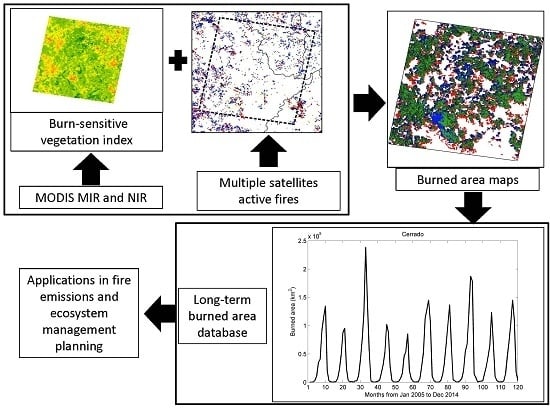An Algorithm for Burned Area Detection in the Brazilian Cerrado Using 4 µm MODIS Imagery
Abstract
:1. Introduction
2. Data and Methods
2.1. Data
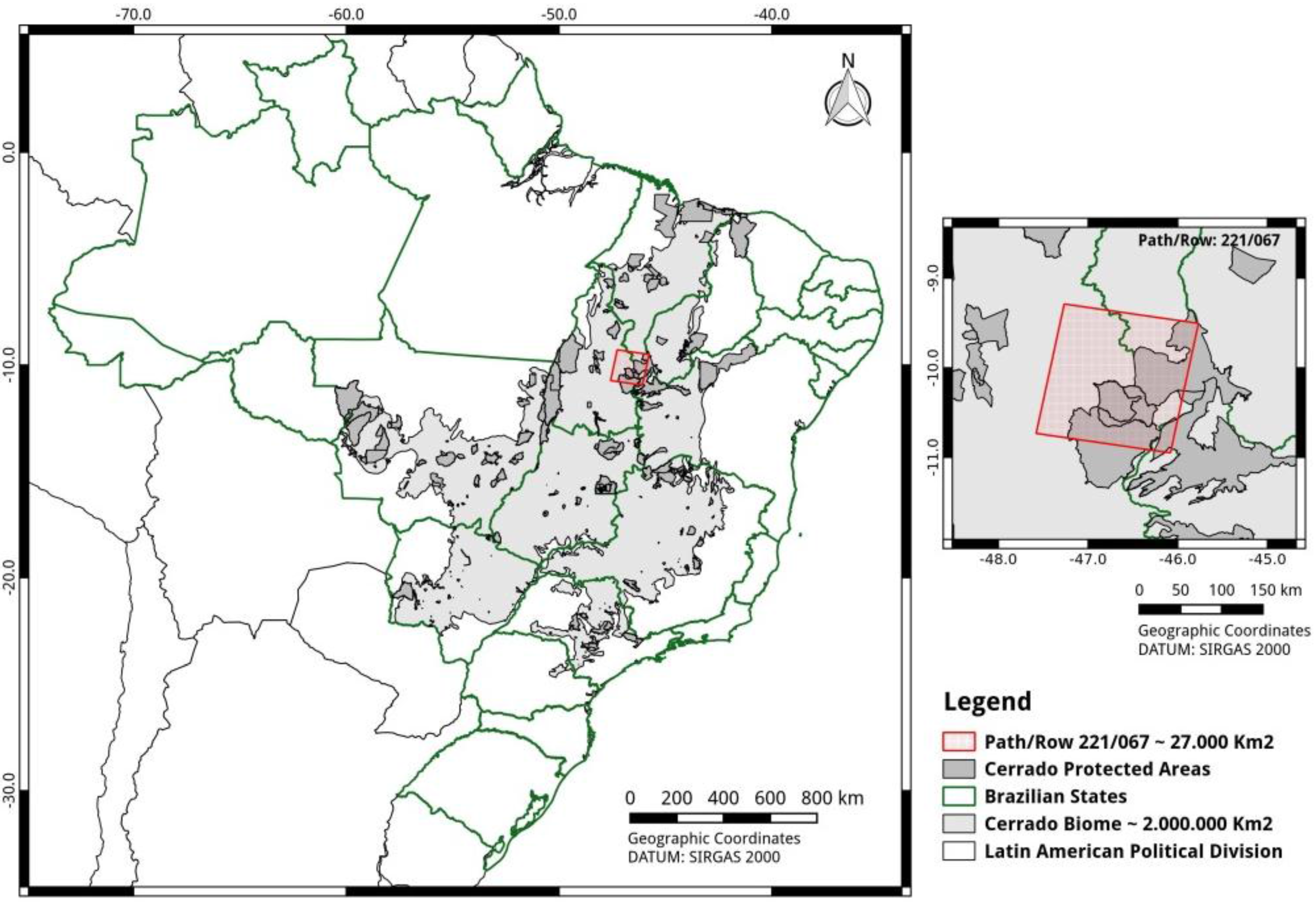
| Year | May | Jun | July | August | September | October |
|---|---|---|---|---|---|---|
| 2005 | 7th, 23rd | 8th, 24th | 9th | |||
| 2006 | 23rd | 8th, 24th | 26th | 11th, 27th | 28th | |
| 2007 | 26th | 27th | 13th, 29th | 14th, 30th | 15th | 1st |
| 2008 | 13th | 15th, 31st | 16th | 17th | ||
| 2009 | 2nd | 3rd, 19th | ||||
| 2010 | 3rd, 19th | 5th | 6th, 22nd | 7th, 23rd |
2.2. Description of the Algorithm
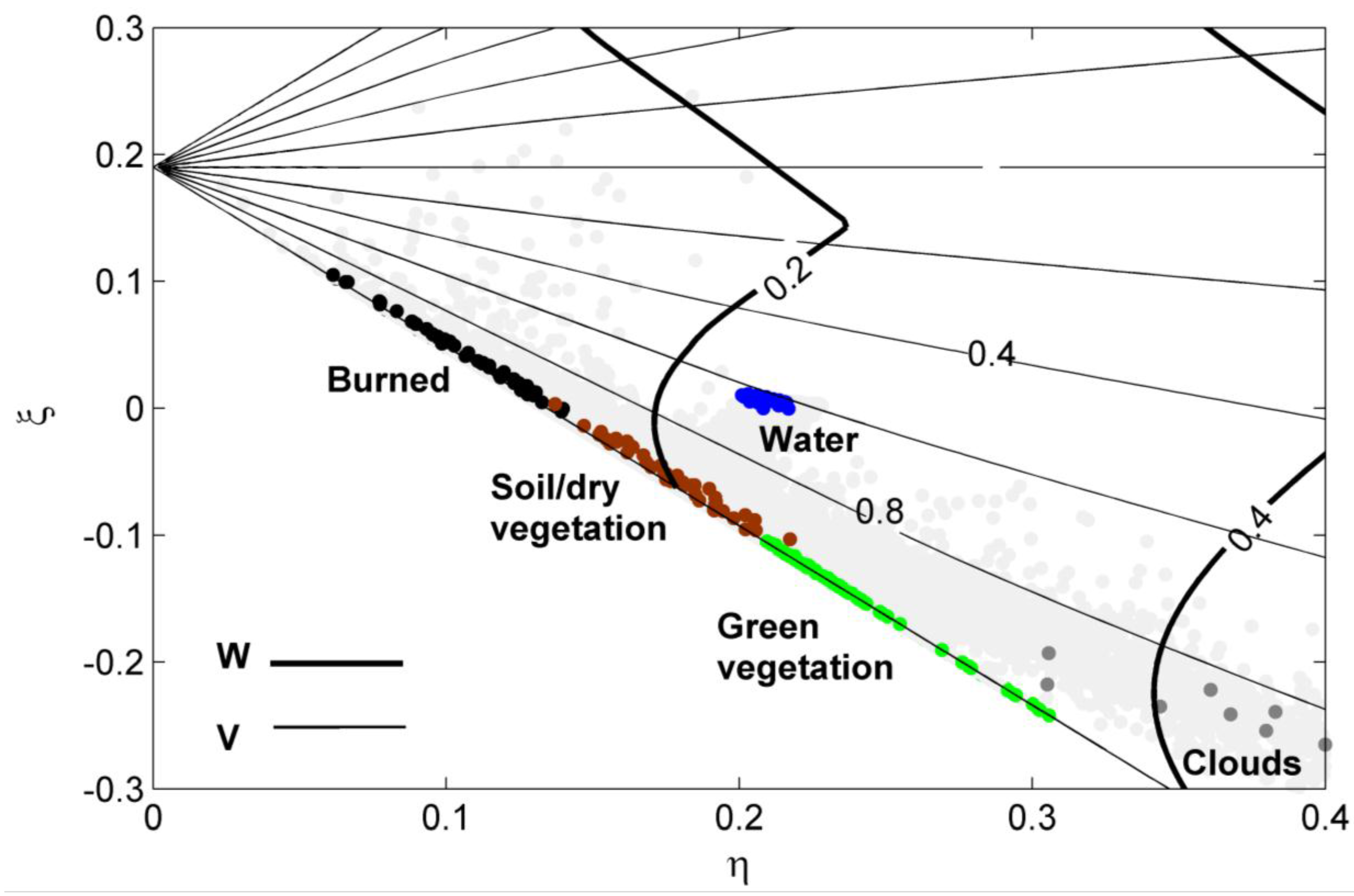
2.2.1. First Step: Pre-Processing
2.2.2. Second Step: Temporal Composites
2.2.3. Third Step: Selection of Burned Pixels (Stage I)
- the pixel belongs to a 3 × 3 pixel buffer matrix;
- W2 ≤ 0.16; and
- ΔW = W2 − W1 ≤ 0.
2.2.4. Fourth Step: Selection of Burned Pixels (Stage II)
- Let all pixels classified as burnt pixels in stage I be considered as seed points;
- For each seed point, let N be the total number of seed points inside a grid of 5 × 5 pixels centered at the considered seed point; in case N ≥ 3, let Ŵ and δW be the mean and the mean absolute deviation of seed points within the grid. Let W* be the value of W for a pixel inside the grid that is not a seed point; this pixel is then classified as a burned area pixel and considered as a new seed point if the two following conditions are fulfilled:
- ΔW* = W* 2 − W* 1 ≤ 0;
- W* ≤ Ŵ + (δW).
- Step II is recursively performed until no new seed points are generated.
- The burned area is obtained by summing up all identified burned area pixels.
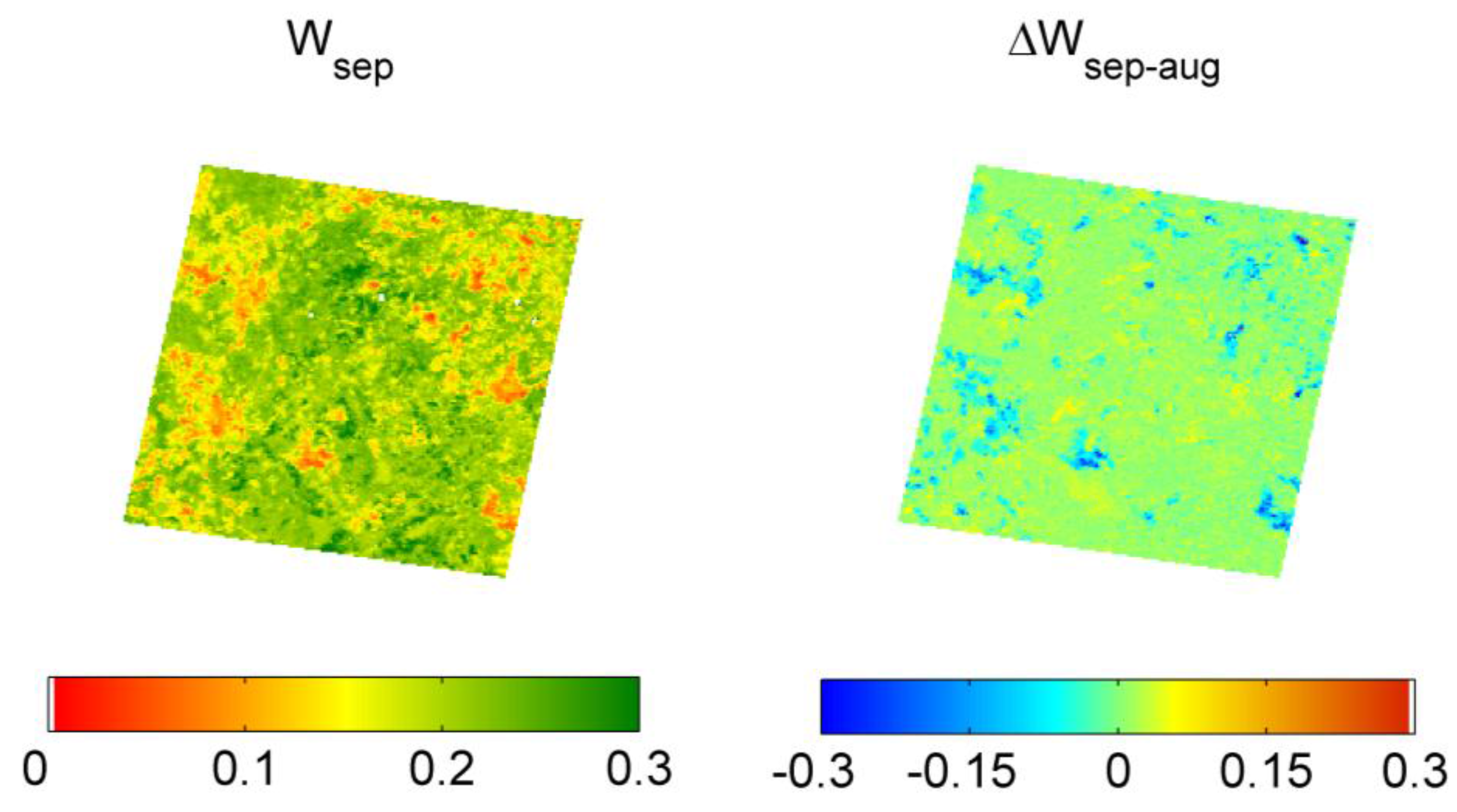
2.3. Validation Procedure
| Reference Map | ||||
|---|---|---|---|---|
| Burned | Unburned | |||
| BA Product | Burned | a | b | a + b |
| Unburned | c | d | c + d | |
| a + c | b + d | a + b + c + d | ||
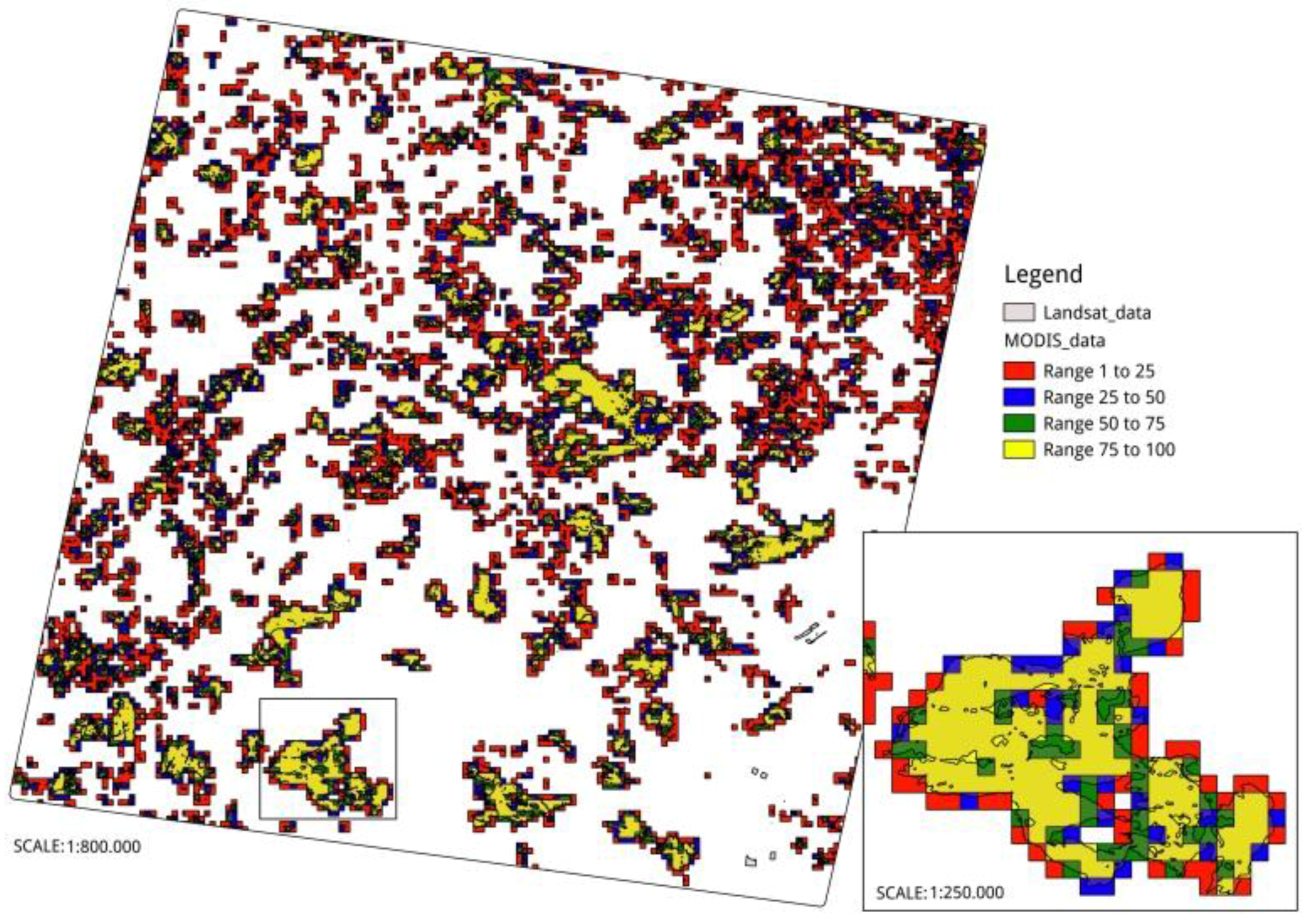
3. Results and Discussion
3.1. Accuracy Assessment
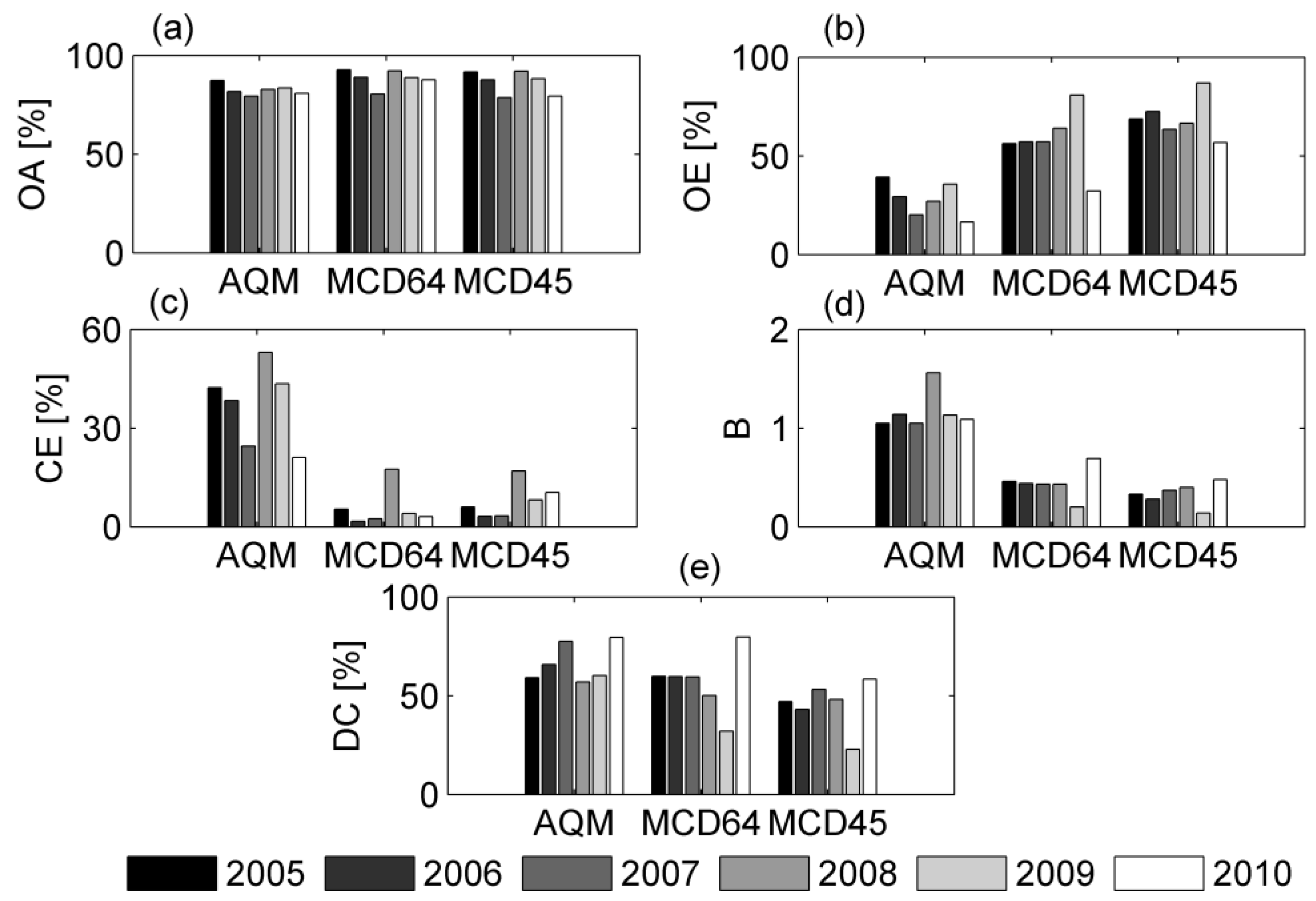
3.2. Spatial Errors
| Hits | Omissions | Commissions | |
|---|---|---|---|
| AQM | 28,255 L = 44%; H = 56% | 23,637 L = 65%; H = 35% | 14,581 O = 58%; ∂S = 42% |
| MCD64A1 | 13425 L = 22%; H = 78% | 38467 L = 65%; H = 35% | 579 O = 58%; ∂S = 42% |
| MCD45A1 | 9332 L = 24%; H = 76% | 42560 L = 60%; H = 40% | 786 O = 52%; ∂S = 48% |
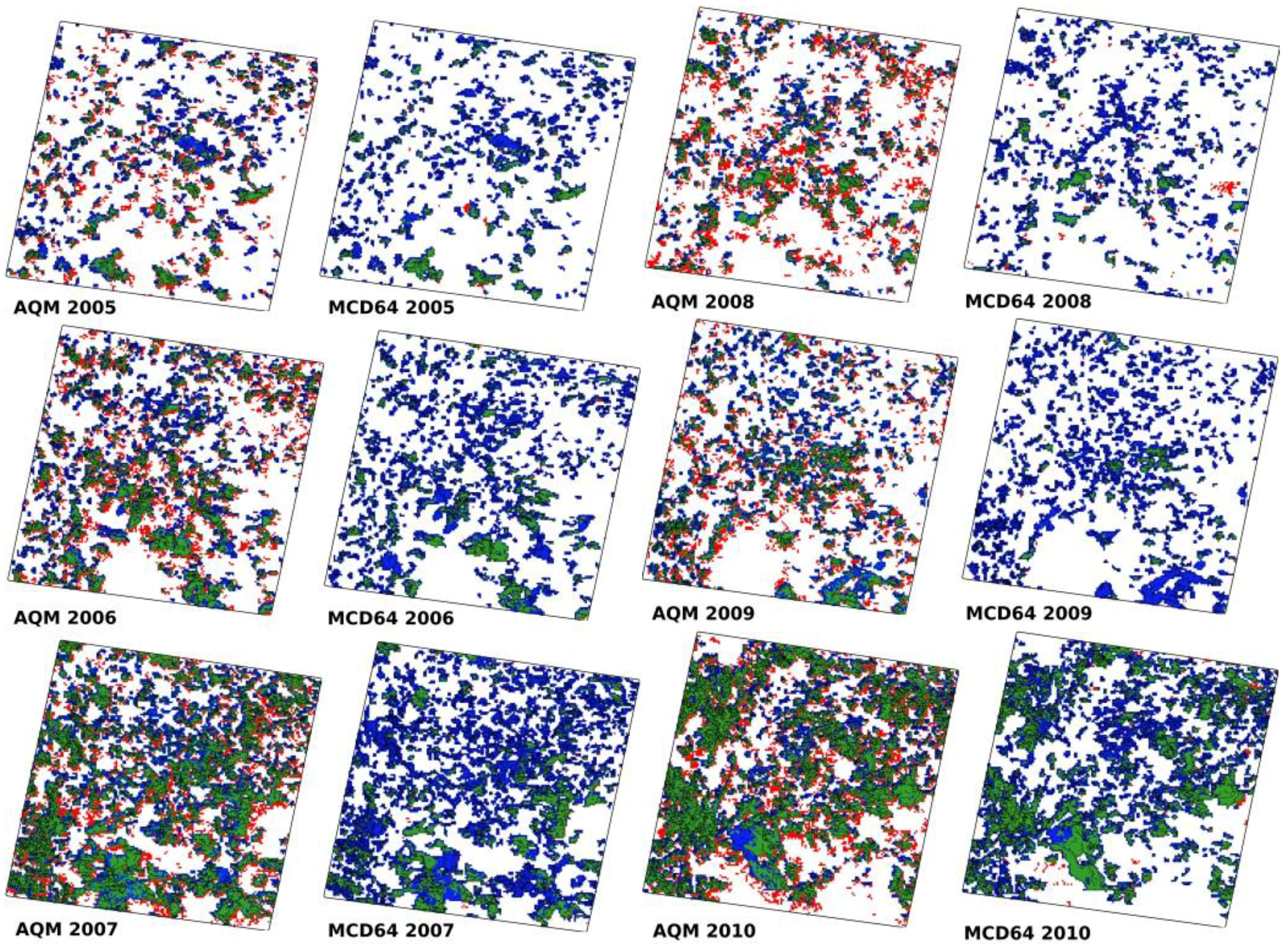
| AQM | Hits | Omissions | Commissions | Distribution of Scars According to Size | |
|---|---|---|---|---|---|
| by Number | by Burned Area | ||||
| 2008 (J) | 2621 L = 54%; H = 46% | 2769 L = 71%; H = 29% | 2980 O = 87%; ∂S = 13% | Small = 85% Medium = 13% Large = 1% | Small = 17% Medium = 49% Large = 34% |
| 2005 (JA) | 2102 L = 49%; H = 51% | 3459 L = 65%; H = 35% | 1539 O = 88%; ∂S = 12% | Small = 90% Medium = 9% Large = 1% | Small = 16% Medium = 38% Large = 46% |
| 2009 (JA) | 2863 L = 53%; H = 47% | 4427 L = 70%; H = 30% | 2201 O = 66%; ∂S = 34% | Small = 89% Medium = 10% Large = 1% | Small = 17% Medium = 43% Large = 40% |
| 2006 (JJAS) | 4066 L = 48%; H = 52% | 4324 L = 65%; H = 35% | 2530 O = 71%; ∂S = 29% | Small = 89% Medium = 10% Large = 1% | Small = 19% Medium = 39% Large = 42% |
| 2010 (JJAS) | 8484 L = 38%; H = 62% | 3833 L = 59%; H = 41% | 2697 O = 30%; ∂S = 70% | Small = 87% Medium = 11% Large = 2% | Small = 8% Medium = 27% Large = 64% |
| 2007 (JJA) | 8119 L = 41%; H = 59% | 4825 L = 60%; H = 40% | 2634 O = 20%; ∂S = 80% | Small = 86% Medium = 12% Large = 2% | Small = 11% Medium = 31% Large = 58% |
3.3. Temporal Errors
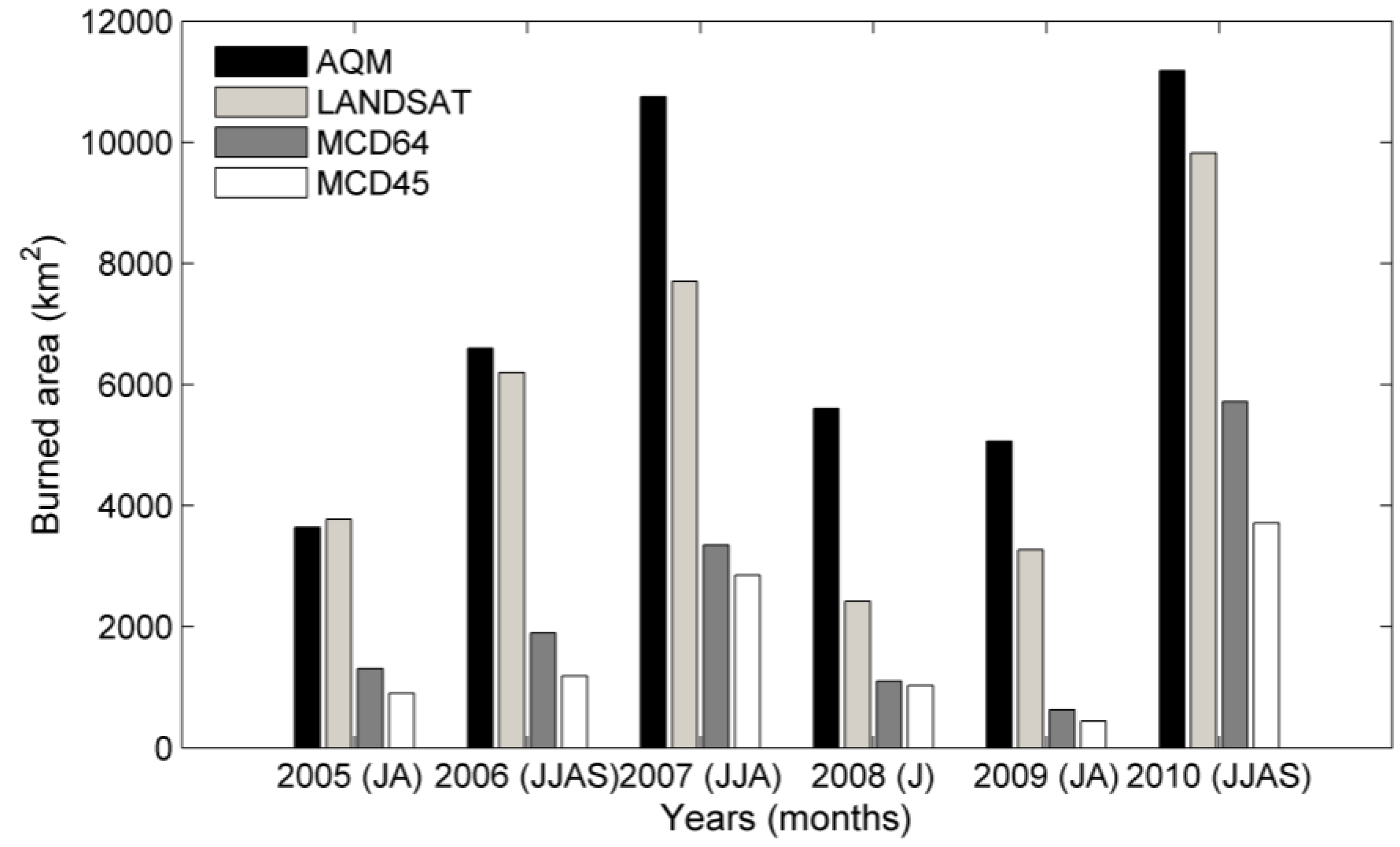
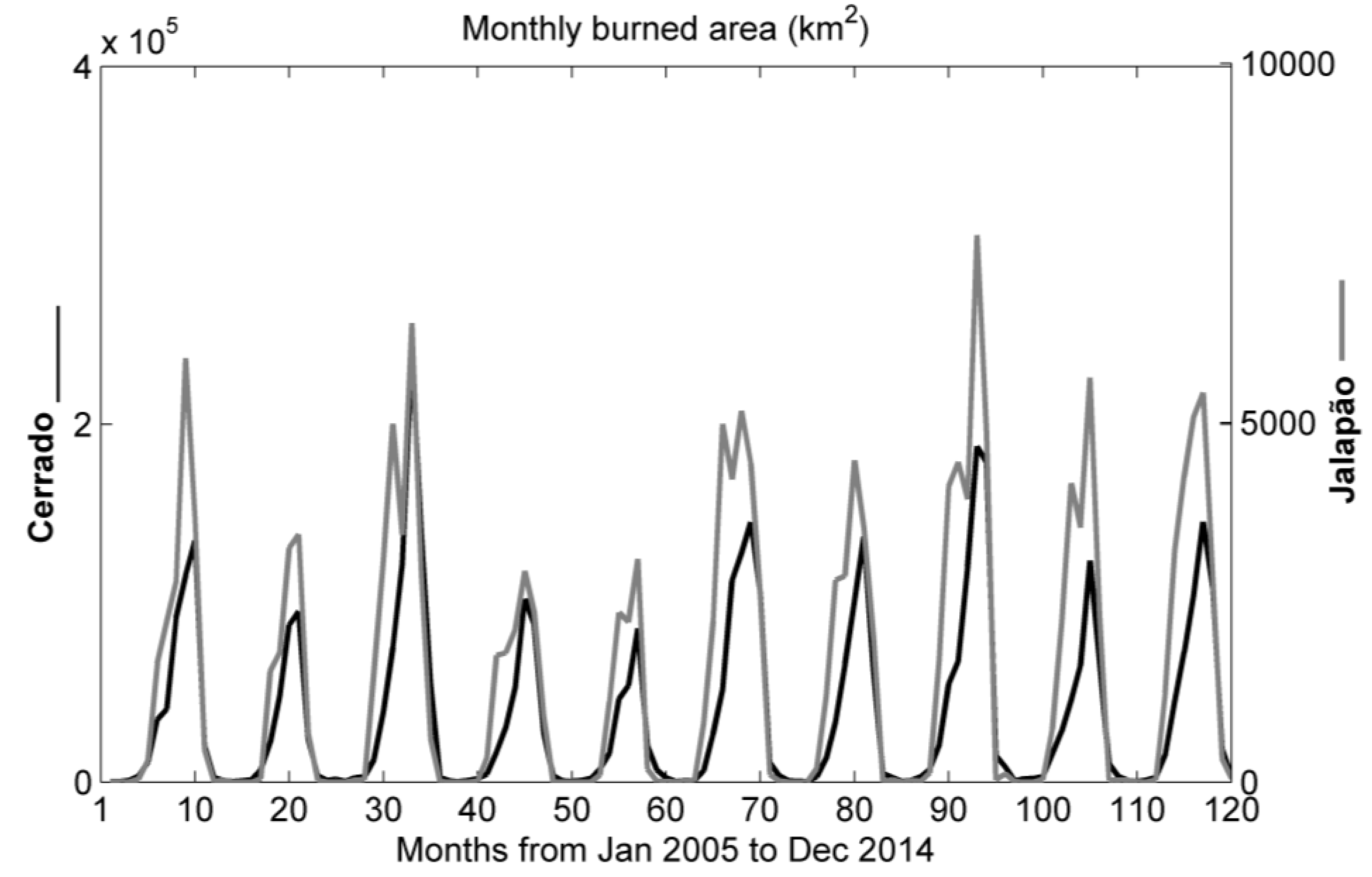
3.4. Climatic Drivers
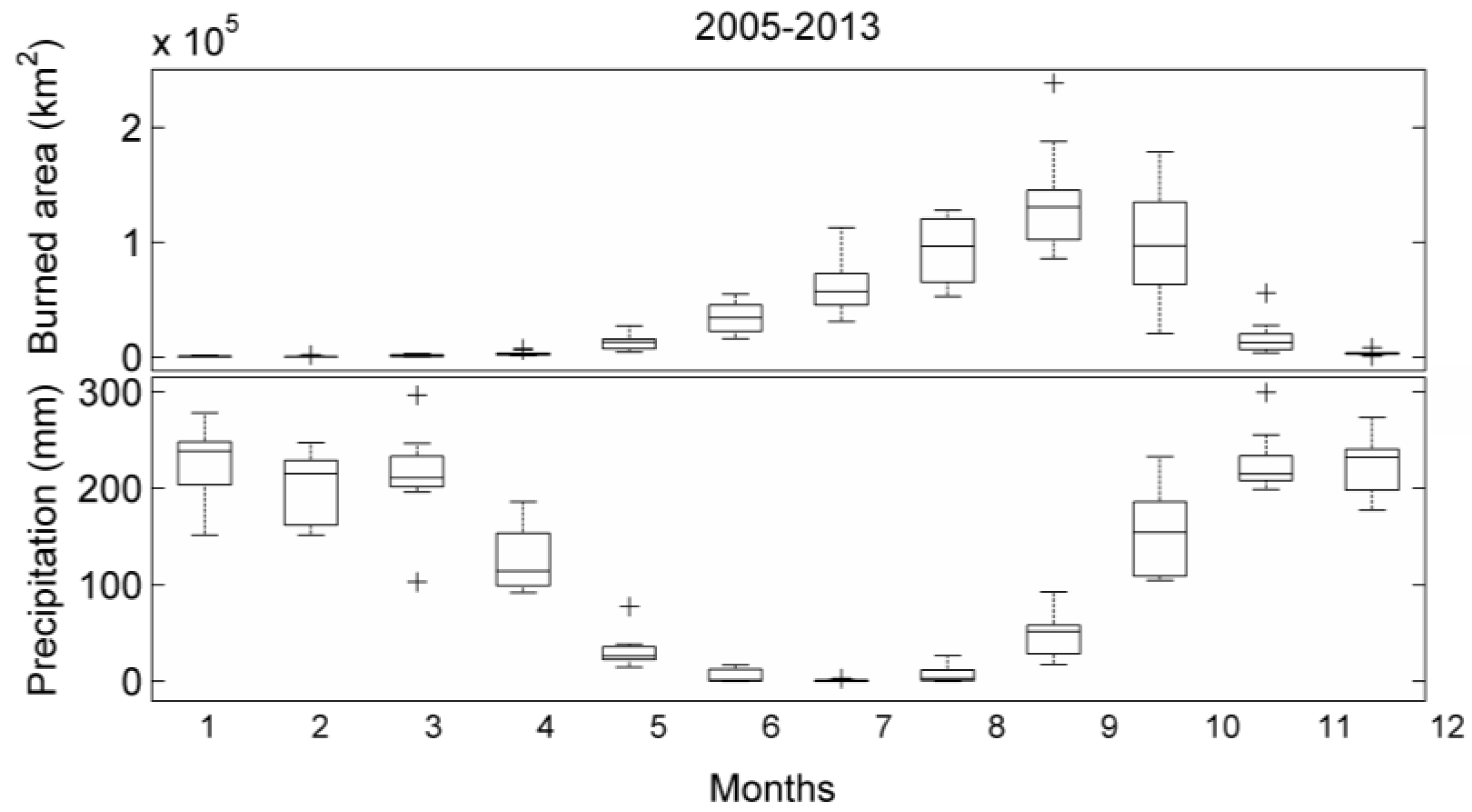
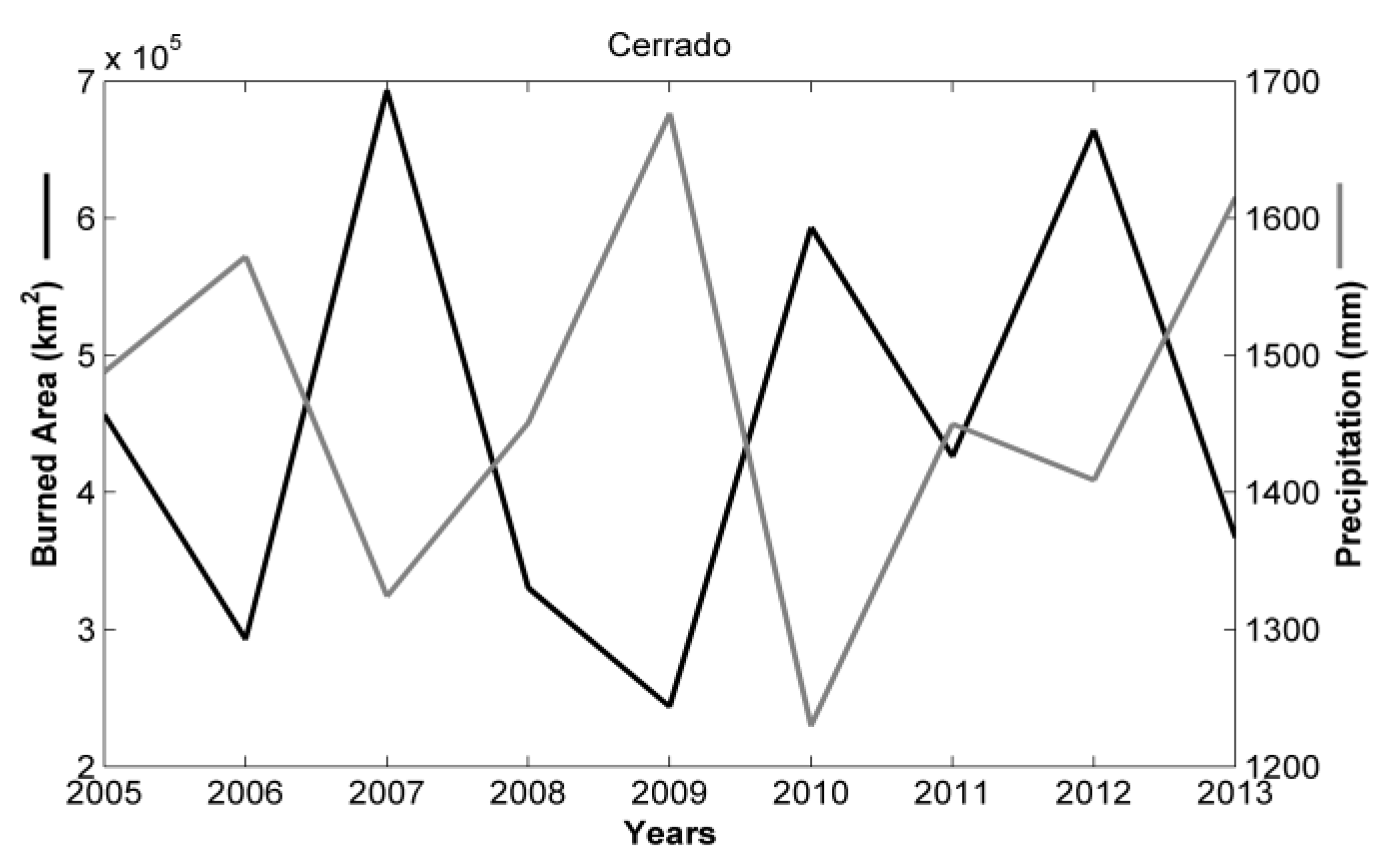
4. Conclusions
Acknowledgments
Author Contributions
Conflicts of Interest
References
- Stocker, T.; Qin, D.; Plattner, G.; Tignor, M.; Allen, S.; Boschung, J.; Nauels, A.; Xia, Y.; Bex, V.; Midgley, P. IPCC 2013: Climate Change 2013: The Physical Science Basis, Proceedings of the Contribution of Working Group I to the Fifth Assessment Report of the Intergovernmental Panel on Climate Change, Stockholm, Sweden, 23–26 September 2013; Cambridge University Press: Cambridge, UK; New York, NY, USA, 2014; pp. 213–214.
- MCTI—Ministério Para Ciência, Tecnologia e Inovação (2013) Estimativas Anuais de Emissões de Gases de Efeito Estufa no Brasil. MCTI, Brasília. Available online: http://www.mct.gov.br/upd_blob/0226/226591.pdf (accessed on 14 September 2015).
- Pereira, J.M.C.; Setzer, A.W. Spectral characteristics of fire scars in Landsat-5 TM images of Amazônia. Int. J. Remote Sens. 1993, 14, 2061–2078. [Google Scholar] [CrossRef]
- Setzer, A.W.; Pereira, M.C.P. Amazonia biomass burnings in 1987 and an estimate of their tropospheric emissions. Ambio 1991, 20, 19–22. [Google Scholar]
- Pivello, V. The use of fire in the Cerrado and Amazonian rainforests of Brazil: Past and present. Fire Ecol. 2011, 7, 24–39. [Google Scholar] [CrossRef]
- Nepstad, D.C.; Stickler, C.M.; Soares-Filho, B.; Merry, F. Interactions among Amazon land use, forests and climate: Prospects for a near-term forest tipping point. Philos. Trans. R. Soc. 2008, 363, 1737–1746. [Google Scholar] [CrossRef] [PubMed]
- Nepstad, D.C.; Verssimo, A.; Alencar, A.; Nobre, C.; Lima, E.; Lefebvre, P.; Schlesinger, P.; Potter, C.; Moutinho, P.; Mendoza, E.; et al. Large scale improverishment of Amazonian forests by logging and fire. Nature 1999, 398, 505–508. [Google Scholar] [CrossRef]
- Gillet, N.P.; Weaver, A.J.; Zwiers, F.W.; Flannigan, M.D. Detecting the effect of climate change on Canadian forest fires. Geophys. Res. Lett. 2004, 31, 1–4. [Google Scholar] [CrossRef]
- Westerling, A.L.; Hidalgo, H.G.; Cayan, D.R.; Swetnam, T. Warming and earlier spring increases western US forest wildfire activity. Science 2006, 313, 940–943. [Google Scholar] [CrossRef] [PubMed]
- Flannigan, M.D.; Krawchuk, M.A.; Groot, W.J.; Wotton, B.M.; Gowman, L.M. Implications of changing climate for global wildland fire. Int. J. Wildland Fire 2009, 18, 483–507. [Google Scholar] [CrossRef]
- Aldersley, A.; Murray, S.J.; Cornell, S.E. Global and regional analysis of climate and human drivers of wild-fire. Sci. Total Environ. 2011, 409, 3472–3481. [Google Scholar] [CrossRef] [PubMed]
- Pereira, M.G.; Calado, T.J.; DaCamara, C.C.; Calheiros, T. Effects of regional climate change on rural fires in Portugal. Clim. Res. 2013, 57, 187–200. [Google Scholar] [CrossRef]
- Hoffman, W.A.; Schroeder, W.; Jackson, R.B. Regional feed-backs among fire, climate, and tropical deforestation. J. Geophys. Res. 2003, 108. [Google Scholar] [CrossRef]
- Cardoso, M.F.; Hurtt, G.C.; Moore, B.; Nobre, C.A.; Prins, E. Projecting future fire activity in Amazonia. Glob. Chang. Biol. 2003, 9, 656–669. [Google Scholar] [CrossRef]
- Hutyra, L.R.; Munger, J.W.; Nobre, C.A.; Saleska, S.R.; Vieira, S.A.; Wofsy, S.C. Climatic variability and vegetation vulnerability in Amazonia. Geophys. Res. Lett. 2005, 32. [Google Scholar] [CrossRef]
- Scholze, M.; Knorr, W.; Arnell, N.W.; Prentice, C. A climate-change risk analysis for world ecosystems. Proc. Natl. Acad. Sci. USA 2006, 103, 13116–13120. [Google Scholar] [CrossRef] [PubMed]
- Li, W.; Fu, R.; Dickinson, R.E. Rainfall and its seasonality over the Amazon in the 21st century as assessed by the coupled models for the IPCC AR4. J. Geophys. Res. 2006, 111. [Google Scholar] [CrossRef]
- Liu, Y.; Stanturf, J.; Goodrick, S. Trends in global wildfire potential in a changing climate. For. Ecol. Manag. 2010, 259, 685–697. [Google Scholar] [CrossRef]
- Stocks, B.J.; Goldammer, J.G.; Frost, P.G.H.; Cahoon, D.R. Towards the development of an informed global policy on vegetation fires: What role for remote sensing? In Global and Regional Vegetation Fire Monitoring from Space: Planning a Coordinated International Effort; Ahern, F., Goldammer, J.G., Justice, C.O., Eds.; SPB Academic Publishing BV: Hague, The Netherlands, 2001; pp. 35–46. [Google Scholar]
- Plummer, S.; Arino, O.; Simon, M.; Steffen, W. Establishing an earth observation product service for the terrestrial carbon community: The GLOBCARBON initiative. Mitig. Adapt. Strateg. Glob. Chang. 2006, 11, 97–111. [Google Scholar] [CrossRef]
- Roy, D.P.; Boschetti, L.; Justice, C.O.; Ju, J. The Collection 5MODIS burned area product: Global evaluation by comparison with the MODIS active fire product. Remote Sens. Environ. 2008, 112, 3690–3707. [Google Scholar] [CrossRef]
- Tansey, K.; Gregoire, J.M.; Defourny, P.; Leigh, R.; Pekel, J.F.O.; van Bogaert, E.; Bartholome, E. A new, global, multi-annual (2000–2007) burnt area product at 1 km resolution. Geophys. Res. Lett. 2008, 35. [Google Scholar] [CrossRef]
- Giglio, L.; van der Werf, G.R.; Randerson, J.T.; Collatz, G.J.; Kasibhatla, P.S. Global estimation of burned area using MODIS active fire observations. Atmos. Chem. Phys. 2006, 6, 957–974. [Google Scholar] [CrossRef]
- Giglio, L.; Randerson, J.T.; van der Werf, G.R.; Kasibhatla, P.S.; Collatz, G.J.; Morton, D.C.; DeFries, R.S. Assessing variability and long-term trends in burned area by merging multiple satellite fire products. Biogeosciences 2010, 7, 1171–1186. [Google Scholar] [CrossRef]
- Boschetti, L.; Eva, H.D.; Brivio, P.A.; Grégoire, J.M. Lessons to be learned from the comparison of the three satellite-derived biomass burning products. Geophys. Res. Lett. 2004, 31. [Google Scholar] [CrossRef]
- Chang, D.; Song, Y. Comparison of L3JRC and MODIS global burned area products from 2000 to 2007. J. Geophys. Res. 2009, 114. [Google Scholar] [CrossRef]
- Setzer, A.; Morelli, F.; Lombardi, R. Estimativa quinzenal de áreas queimadas nas imagens MODIS do INPE. In O Sensor MODIS e suas Aplicações Ambientais no Brasil; Rudorff, B.F.T., Shimabukuro, Y.E., Ceballos, J.C., Eds.; Bookimage: S.J.Campos, Brazil, 2007; pp. 403–417. [Google Scholar]
- Melchiori, E.A.; Setzer, A.W.; Morelli, F.; Libonati, R.; Candido, P.; Jesus, S.A. Landsat-Tm/Oli algorithm for burned areas in the Brazilian Cerrado—Preliminary results. In Proceedings of VII International Conference on Forest Fire Research, Coimbra, Portugal, 17–20 November 2014.
- Haddad, Z.S.; Smith, E.A.; Kummerow, C.D.; Iguchi, T.; Farrar, M.R.; Durden, S.L.; Alves, M.; Olson, W.S. The TRMM “Day-1” radar/radiometer combined rain-profiling algorithm. J. Meteorol. Soc. 1997, 75, 799–809. [Google Scholar]
- Silva, J.F.; Farin, M.R.; Felfili, J.M.; Klink, C.A. Spatial heterogeneity, land use and conservation in the cerrado region of Brazil. J. Biogeogr. 2006, 33, 536–548. [Google Scholar] [CrossRef]
- Roy, D.P.; Jin, Y.; Lewis, P.E.; Justice, C.O. Prototyping a global algorithm for systematic fire-affected area mapping using MODIS time series data. Remote Sens. Environ. 2005, 97, 137–162. [Google Scholar] [CrossRef]
- Giglio, L.; Loboda, T.; Roy, D.P.; Quayle, B.; Justice, C.O. An active-fi re based burned area mapping algorithm for the MODIS sensor. Remote Sens. Environ. 2009, 113, 408–420. [Google Scholar] [CrossRef]
- Barbosa, P.M.; Gregoire, J.-M.; Pereira, J.M.C. An algorithm for extracting burned areas from time series of AVHRR GAC data applied at a continental scale. Remote Sens. Environ. 1999, 69, 253–263. [Google Scholar] [CrossRef]
- Pereira, J.M.C. A comparative evaluation of NOAA/AVHRR vegetation indexes for burned surface detection and mapping. IEEE Trans. Geosci. Remote Sens. 1999, 37, 217–226. [Google Scholar] [CrossRef]
- Libonati, R.; DaCamara, C.C.; Pereira, J.M.C.; Peres, L.F. Retrieving middle infrared reflectance for burned area mapping in tropical environments using MODIS. Remote Sens. Environ. 2010, 114, 831–843. [Google Scholar] [CrossRef]
- Libonati, R.; DaCamara, C.C.; Pereira, J.M.C.; Peres, L.F. On a new coordinate system for improved discrimination of vegetation and burned areas using MIR/NIR information. Remote Sens. Environ. 2011, 114, 831–843. [Google Scholar] [CrossRef]
- França, H.; Setzer, A.W. AVHRR analysis of savanna site through a fire season in Brazil. Int. J. Remote Sens. 2001, 22, 2449–2461. [Google Scholar] [CrossRef]
- Richardson, A.J.; Wiegand, C.L. Distinguishing vegetation from soil background information. Photogramm. Eng. Remote Sens. 1997, 43, 1541–1552. [Google Scholar]
- Pinty, B.; Lavergne, T.; Widlowski, J.-L.; Gobron, N.; Verstraete, M.M. On the need to observe vegetation canopies in the near-infrared to estimate visible light absorption. Remote Sens. Environ. 2008, 113, 10–23. [Google Scholar] [CrossRef]
- Kaufman, Y.J.; Remer, L. Detection of forests using mid-IR reflectance: An application for aerosol studies. IEEE Trans. Geosci. Remote Sens. 1994, 32, 672–683. [Google Scholar] [CrossRef]
- Sousa, A.M.O.; Pereira, J.M.C.; Silva, J.M.N. Evaluating the performance of multitemporal image compositing algorithms for burned area analysis. Int. J. Remote Sens. 2003, 24, 1219–1236. [Google Scholar] [CrossRef]
- Holben, B.N. Characteristics of maximum-value composite images from temporal AVHRR data. Int. J. Remote Sens. 1986, 7, 1417–1437. [Google Scholar] [CrossRef]
- Barbosa, P.M.; Pereira, J.M.C.; Gregoire, J.-M. Compositing criteria for burned area assessment using multitemporal low resolution satellite data. Remote Sens. Environ. 1998, 65, 38–49. [Google Scholar] [CrossRef]
- Stroppiana, D.; Tansey, K.; Gregoire, J-M.; Pereira, J.M.C. An algorithm for mapping burnt areas in Australia using SPOT-VEGETATION data. IEEE Trans. Geosci. Remote Sens. 2003, 41, 907–909. [Google Scholar] [CrossRef]
- Chuvieco, E.; Englefield, P.; Trischenko, A.; Lio, Y. Generation of long time series of burn area maps of the boreal forest from NOAA-AVHRR composite data. Int. J. Remote Sens. 2008, 23, 5103–5110. [Google Scholar] [CrossRef]
- Roy, D.P.; Giglio, L.; Kendall, J.D.; Justice, C.O. Multi-temporal active-fire based burn scar detection algorithm. Int. J. Remote Sens. 1999, 20, 1031–1038. [Google Scholar] [CrossRef]
- Fraser, R.H.; Li, Z.; Cihlar, J. Hotspot and NDVI differencing synergy (HANDS): A new technique for burned area mapping over boreal forest. Remote Sens. Environ. 2000, 74, 362–376. [Google Scholar] [CrossRef]
- Pu, R.; Gong, P.; Li, Z.; Scarborough, J. A dynamic algorithm for wildfire mapping with NOAA/AVHRR data. Int. J. Wildland Fire 2004, 13, 275–285. [Google Scholar] [CrossRef]
- George, C.; Rowland, C.; Gerard, F.; Balzter, H. Retrospective mapping of burnt areas in Central Siberia using a modification of the normalized difference water index. Remote Sens. Environ. 2006, 104, 346–359. [Google Scholar] [CrossRef]
- Loboda, T.; O’Neal, K.J.; Csiszar, I. Regionally adaptable dNBR-based algorithm for burned area mapping from MODIS data. Remote Sens. Environ. 2007, 109, 429–442. [Google Scholar] [CrossRef]
- Schroeder, W.; Csiszar, I.; Morisette, J. Quantifying the impact of cloud obscuration on remote sensing of active fires in the Brazilian Amazon. Remote Sens. Environ. 2008, 112, 456–470. [Google Scholar] [CrossRef]
- Schroeder, W.; Morisette, J.; Csiszar, I.; Giglio, L.; Morton, D.; Justice, C.O. Characterizing vegetation fire dynamics in Brazil through multisatellite data: Common trends and practical issues. Earth Interact. 2005, 9, 1–26. [Google Scholar] [CrossRef]
- Story, M.; Congalton, R.G. Accuracy assessment: A user’s perspective. Photogramm. Eng. Remote Sens. 1986, 52, 397–399. [Google Scholar]
- Gong, P.; Howarth, P.J. The use of structural information for improving land-cover classification accuracies at the rural-urban fringe. Photogramm. Eng. Remote Sens. 1990, 56, 67–73. [Google Scholar]
- Karaska, M.A.; Huguenin, R.L.; van Blaricom, D.; Savitsky, B. Subpixel classification of cypress and tupelo trees in TM imagery. In Proceedings of the 1995 ACSM/ASPRS Annual Convention and Exposition, Charlotte, NC, USA, 27 February–2 March 1995; pp. 856–865.
- Foody, G.M. Approaches for the production and evaluation of fuzzy land cover classications from remotely-sensed data. Int. J. Remote Sens. 1996, 17, 1317–1340. [Google Scholar] [CrossRef]
- Binaghi, E.; Brivio, P.A.; Ghezzi, P.; Rampini, A. A fuzzy set-based accuracy assessment of soft classification. Pattern Recognit. Lett. 1999, 20, 935–948. [Google Scholar] [CrossRef]
- Boschetti, L.; Flasse, S.P.; Brivio, P.A. Analysis of the conflict between omission and commission in low spatial resolution dichotomic thematic products: The pareto boundary. Remote Sens. Environ. 2004, 91, 280–292. [Google Scholar] [CrossRef]
- Padilla, M.; Stehman, S.V.; Litago, J.; Chuvieco, E. Assessing the temporal stability of the accuracy of a time series of burned area products. Remote Sens. 2014, 6, 2050–2068. [Google Scholar] [CrossRef]
- Tsela, P.; Wessels, K.; Botai, J.; Archibald, S.; Swanepoel, D.; Steenkanp, K.; Frost, P. Validation of the tow standard MODIS satellite burned area products and an Empirically-derived merged product in South Africa. Remote Sens. 2014, 6, 1275–1293. [Google Scholar] [CrossRef]
- Wilks, D. Statistical Methods in the Atmospheric Sciences, 2nd ed.; Academic Press: Waltham, MA, USA, 2006; p. 627. [Google Scholar]
- Padilla, M.; Stehman, S.V.; Ramo, R.; Corti, D.; Hantson, S.; Olive, P.; Alonso-Canas, I.; Bradley, A.V.; Tansey, K.; Mota, B.; et al. Comparing the accuracies of remote sensing global burned area products using stratified random sampling and estimation. Remote Sens. Environ. 2015, 160, 114–121. [Google Scholar] [CrossRef]
- Mouillot, F.; Schultz, M.G.; Yue, C.; Cadule, P.; Tansey, K.; Ciais, P.; Chuvieco, C. Ten years of global burned area products from spaceborne remote sensing—A review: Analysis of user needs and recommendations for future developments. Int. J. Appl. Earth Obs. Geoinf. 2014, 26, 64–79. [Google Scholar] [CrossRef]
© 2015 by the authors; licensee MDPI, Basel, Switzerland. This article is an open access article distributed under the terms and conditions of the Creative Commons Attribution license (http://creativecommons.org/licenses/by/4.0/).
Share and Cite
Libonati, R.; DaCamara, C.C.; Setzer, A.W.; Morelli, F.; Melchiori, A.E. An Algorithm for Burned Area Detection in the Brazilian Cerrado Using 4 µm MODIS Imagery. Remote Sens. 2015, 7, 15782-15803. https://doi.org/10.3390/rs71115782
Libonati R, DaCamara CC, Setzer AW, Morelli F, Melchiori AE. An Algorithm for Burned Area Detection in the Brazilian Cerrado Using 4 µm MODIS Imagery. Remote Sensing. 2015; 7(11):15782-15803. https://doi.org/10.3390/rs71115782
Chicago/Turabian StyleLibonati, Renata, Carlos C. DaCamara, Alberto W. Setzer, Fabiano Morelli, and Arturo E. Melchiori. 2015. "An Algorithm for Burned Area Detection in the Brazilian Cerrado Using 4 µm MODIS Imagery" Remote Sensing 7, no. 11: 15782-15803. https://doi.org/10.3390/rs71115782






